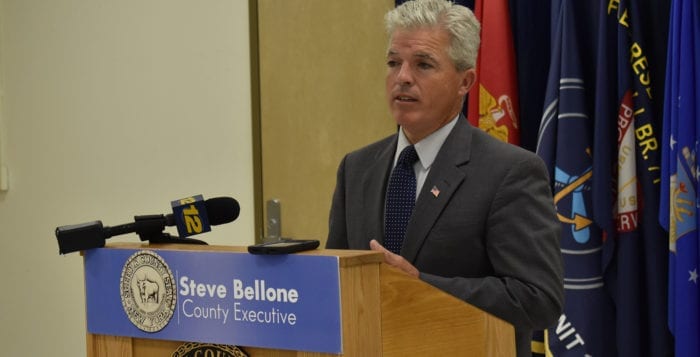They’ve got the power.
Brookhaven Town voted 6-0 with one abstention in favor of lifting a restrictive covenant on an application by Caithness Energy LLC to construct a new, 600-megawatt energy generation plant in Yaphank at a July 12 meeting. When the board approved the independent power producer’s initial 2014 application, when it sought to construct a 750-megawatt facility, it imposed strict regulations aimed at preventing Caithness from making any changes to its plans, or face starting over from square one getting approvals. The power company asked town officials to lift the covenant for its present-day plans that feature newly available technology — which is what required the second vote, preceded by a June 26 public hearing.
Councilwoman Valerie Cartright (D-Port Jefferson Station) abstained from the July 12 vote after voting against the application in 2014, which passed 5-2. Supervisor Ed Romaine (R) voted “no” in 2014, but approved the lifting of the restrictive covenant this time around.

“In requiring such covenant proposed in 2015, the town board did not intend to require the applicant return for covenant amendments when technology changes or improves, or to construct a less impactful energy generating facility,” Brookhaven Town Attorney Annette Eaderesto read from her office’s findings on the matter. “In fact, the town board finds that in consideration of the health, safety and welfare of the residents of the town, the town shall not regulate or restrict the technology that may be used by the applicant.”
Caithness President Ross Ain said in a statement the company was pleased to hear the town had repealed the restriction.
“We now look forward to consideration and approval of the site plan filed with the Planning Board for what will be the region’s cleanest, most fuel-efficient, and most water-conserving power plant,” Ain said.
Cartright explained she was abstaining from the vote to repeal the restrictive covenant because she thought a vote to either approve or disapprove of Caithness’ entire application would be more appropriate. She also raised a concern about the special use permit issued to Caithness in 2014, which according to her interpretation of town law, expired July 15, 2018.
“That’s under consideration,” Eaderesto said of Cartright’s concern in a phone interview.
The town attorney said she expected the Planning Board to decide if Caithness will be required to reapply for the special use permit for the Yaphank site this week.
Don Miller, a spokesman for Caithness Energy, did not respond to a question raised by email regarding Cartright’s suggestion the company’s special use permit expired Sunday.
Caitness’ renewed request comes as Port Jefferson Village and the town have said a settlement is nearing in an eight-year-long legal fight with Long Island Power Authority over the utility company’s contention its Port Jeff plant’s property taxes are over assessed based on the decreasing energy demand. The settlement would smooth the impact of a potential substantial loss of revenue for the village, Port Jefferson School District, Port Jefferson Free Library and Port Jefferson Fire Department based on a reduced assessment of the plant. It would also prevent the village from being held liable for years of back pay should it have chosen to play out the legal battle in court and lost rather than settling the case. The village has argued a way to make good with LIPA over its decreasingly needed plant could be to increase its output capacity. If constructed, the Caithness II plant, which would be built nearby the company’s first Yaphank plant opened in 2009, could theoretically kill plans to repower the Port Jefferson plant.
However, according to Ain, as of June 26 LIPA has made no commitment to purchase power from the company should a second facility be constructed in Yaphank. It does purchase power from the first Caithness plant.
“The construction of a Caithness II facility will have the inevitable effect of pushing our community off the economic cliff.”
— Margot Garant
The June 26 public hearing drew comments from those in favor of the proposal, many of whom being Longwood school district residents who would likely see a reduction in property taxes, similar to what Port Jeff residents enjoy currently for housing the Port Jefferson Power Station. Environmental groups and other residents opposed the plan, as did Port Jefferson Village Mayor Margot Garant and state Assemblyman Steve Englebright (D-Setauket), who each submitted statements to be read into the record by Cartright against the proposal and urging the board to vote it down June 26.
“The construction of a Caithness II facility will have the inevitable effect of pushing our community off the economic cliff at the end of the proposed period of gradual reductions, while leaving us to deal with an enormous, closed, unusable industrial site which will need serious environmental remediation,” Garant said in her letter read by Cartright. The mayor said she has sent a similar inquiry to the town board as was raised by Cartright regarding the life of the applicant’s special use permit, though has yet to hear back from Brookhaven.
A representative from Sierra Club Long Island, a local chapter of the national nonprofit dedicated to environmental advocacy, spoke out against Caithness II during the June 26 hearing.
“The Sierra Club strongly opposes any attempt to construct a new gas plant on Long Island, and we oppose the Caithness II proposal regardless of the technology involved,” said Shay O’Reilly, an organizer for the nonprofit. “It is absurd to argue that building more fracked gas infrastructure will allow us to meet our clean energy and pollution reduction goals.”
This post was updated July 17 to include comment from Port Jefferson Village Mayor Margot Garant.


















